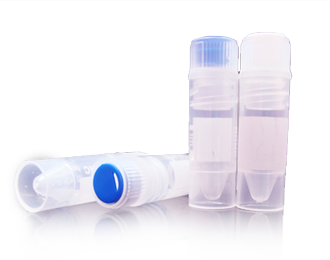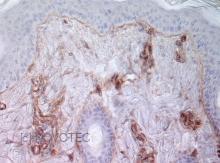
Anticorps > 20421 - Purified freeze-dried antibody to bovine type IV collagen
20421 - Purified freeze-dried antibody to bovine type IV collagen
Type IV collagen is a sheet-forming type of collagen found in basement membranes where it serves a critical scaffolding function. In mammals, six proteins make up the type IV collagen family with the distribution of family members being tissue-specific. Structurally, three collagen IV alpha chains assemble to form a flexible heterotrimeric protomer that can self-assemble into network polymers. Tissue injury in the autoimmune disease Goodpasture syndrome is due to pathogenic autoantibodies targeting the Collagen IV α3 chain. Mutations in COL4A5 are associated with Alport syndrome. [according to RefSeq]
Immunogen : Type IV collagen extracted from bovine lens capsules.
Host : Rabbit.
Polyclonal antibody purified by chromatography.
For research only.
Purified, freeze-dried antibody in 0.1 mL vials. Reconstitute with 0.1 mL distilled water and store aliquots at -20°C.
Unreconstituted
24 months at -20°C.
Reconstituted
Before use aliquot and store at -20°C (6 months). Avoid repeated freeze/thaw cycles.
Applications
IF, IHC, ELISA, SP(RIA).
Working dilutions
ELISA ≥ 1/2000 (OD = 0.5)
IF ≥ 1/40
IHC ≥ 1/500
Optimal dilutions should be determined by the end user.
- #326f
-
IgG
1,7 mg/mL
pH
7,5
ELISA
Optimal working dilution not tested with our current protocol.
IF
With fluorescein anti-rabbit IgG conjugate, optimal working dilution at 1/40 on frozen bovine skin.
IHC
Immunoperoxidase technique with the Envision / Dako kit,0.5% hyaluronidase pretreatment, optimal working dilution at 1/500 on fixed paraffin-embedded bovine skin.
-
Presentation
Type IV collagen is a sheet-forming type of collagen found in basement membranes where it serves a critical scaffolding function. In mammals, six proteins make up the type IV collagen family with the distribution of family members being tissue-specific. Structurally, three collagen IV alpha chains assemble to form a flexible heterotrimeric protomer that can self-assemble into network polymers. Tissue injury in the autoimmune disease Goodpasture syndrome is due to pathogenic autoantibodies targeting the Collagen IV α3 chain. Mutations in COL4A5 are associated with Alport syndrome. [according to RefSeq]
Description
Immunogen : Type IV collagen extracted from bovine lens capsules.
Host : Rabbit.
Polyclonal antibody purified by chromatography.
For research only.
Format
Purified, freeze-dried antibody in 0.1 mL vials. Reconstitute with 0.1 mL distilled water and store aliquots at -20°C.
Stability
Unreconstituted
24 months at -20°C.
Reconstituted
Before use aliquot and store at -20°C (6 months). Avoid repeated freeze/thaw cycles.
Use
Applications
IF, IHC, ELISA, SP(RIA).
Working dilutions
ELISA ≥ 1/2000 (OD = 0.5)
IF ≥ 1/40
IHC ≥ 1/500
Optimal dilutions should be determined by the end user.
Lots
- #326f
-
IgG :
1,7
pH :
7,5
ELISA
Optimal working dilution not tested with our current protocol.
IF
With fluorescein anti-rabbit IgG conjugate, optimal working dilution at 1/40 on frozen bovine skin.
IHC
Immunoperoxidase technique with the Envision / Dako kit,0.5% hyaluronidase pretreatment, optimal working dilution at 1/500 on fixed paraffin-embedded bovine skin.
-
References
- «Long term remodeling of a bilayered living human skin equivalent (Apligraf®) grafted onto nude mice: immunolocalization of human cells and characterization of extracellular matrix. Wound Rep. Reg. 2003, 11, 35-45.»
Guerret S., Govignon E., Hartmann D.J., Ronfard V. - «Immunocytochemical localization of collagen types I, III, IV, and fibronectin in the human dermis. Cell Tissue Res. 1992, 268, 505-511.»
Vitellaro-Zuccarello L., Garbelli R., Dal Pozzo Rossi V. - «Extracellular matrix components of the mouse thymus microenvironment : Ontogenetic studies and modulation by glucocorticods hormones. J. Histochem. Cytochem. 1991, 39, 1539-1546.»
Lannes-Vieira J., Dardenne M., Savino W. - «Extracellular matrix components of the mouse thymic microenvironment. II. In vitro modulation of basement membrane proteins by interferon- : Relationship with thymic epithelial cell proliferation. Cellular Immunology 1991, 137, 329-340.»
Lannes-Vieira J., van der Meide P.H., Savino W. - «Production of fibronectin and collagen types I and III by chick embryo dermal cells cultured on extracellular matrix substrates. Int. J. Dev. Biol. 1989, 33, 267-275.»
Robert J., Hartmann D.J., Sengel P. - «Influence of various extracellular matrix components on the behavior of cultured chick embryo dermal cells. Int. J. Dev. Biol. 1989, 33, 227-237.»
Robert J., Mauger A., Sengel P. - «Morphology of chronic collagen resorption : a study on the late stages of schistosomal granuloma involution. Am. J. Path. 1988, 132, 389-399.»
Andrade Z.A., Grimaud J.A. - «The interstitial matrix of human carcinomas and sarcomas transplanted to the nude mouse : immunolocalization of some human and murine components. Cell. Mol. Biol. 1987, 33, 647-654.»
Duprez A., Guerret S., Vignaud J.M., Plenat F., Hartmann D.J., Grimaud J.A. - «Myofibroblastic stromal reaction in carcinoma of the breast : variations of collagenous matrix and structural glycoproteins. Virchows Arch. 1985, 408, 49-59.»
Lagacé R., Grimaud J.A., Schürch W., Seemayer T.A. - «A procedure for light and electron microscopic intracellular immunolocalization of collagen and fibronectin in rat liver. J. Histochem. Cytochem. 1985, 33, 407-414.»
Clement B., Rissel M., Peyrol S., Mazurier Y., Grimaud J.A., Guillouzo A. - «Mise en évidence du collagène par immunofluorescence au cours du développement du Xénope, Xenopus laevis Daud. CR Soc. Biol. 1982, 176, 494-502.»
Bride M., Benslimane S., Stocker S., Grimaud J.A.



